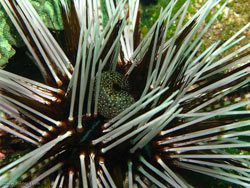Sea urchins are sensitive to touch, light, and chemicals in the water. They do not have a brain. Most sea urchins have five pairs of external gills, placed around the mouth. Their moutha are genrally made up of five calcium carbonate teeth or jaws containing a fleshy tongue-like structure.
Most sea urchins are grazers, feeding mainly on algae, but some are predators feeding on sea cucumbers, and other invertebrates including mussels, polychaetes, sponges, brittle stars and crinoids. Sea urchins are one of the favorite foods of sea otters and is also the main source of nutrition for wolf eels. Other predators include octopuses and triggerfish, which bite off the spines allowint them fish to crack open the shell of the urchin. They have a pharynx, oesophagus, intestines and a rectum.
Sea urchins are male or female and, in most species, the eggs are released into the water. It can take several months before the larva settle to the bottom and become adults. In some species, it can take up tp five years for adults to grow to their maximum size. |

|